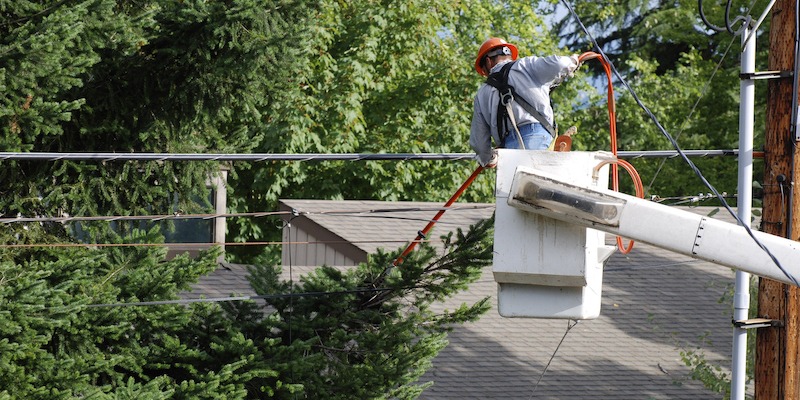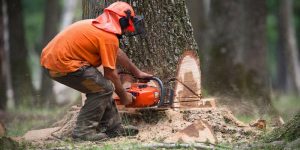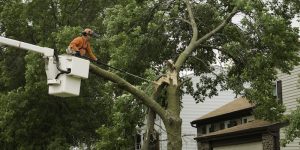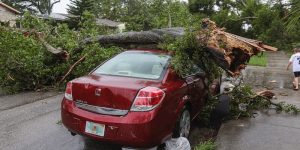How Much Does Tree Trimming Cost?
The average tree trimming costs are around $450, though you can pay as low as $120 or as high as $1,200 depending on your needs. Keep in mind that several variables affect how much it will cost to trim a tree.
Tree height is a very large factor in prices, as it will cost less to trim a smaller tree than a larger tree that is much taller. The health of the tree also plays an important factor, as tree work can be more complex for a tree with a dead branch compared to a healthy tree. The tree type is also important as an oak tree or a pine tree may require a skilled tree expert that uses advanced tree care techniques. If you need additional services such as stump grinding, stump removal, tree maintenance, or tree removal service, then you should expect to pay more for tree trimming service.
Whether you've moved into a new home, want to tidy up your current yard, or have experienced severe weather, many homeowners will find themselves in need of tree trimming services or even emergency tree removal.
Hopefully, you will never experience the stress, danger, and hassle of an emergency tree removal. That said, performing regular maintenance work and having your trees trimmed every few months helps keep them strong, healthy, and able to withstand severe weather, snowfall, or wind.
While most will agree that regularly scheduled tree care is important, finding a reputable tree service company isn't easy, and DIY tree trimming can get dangerous very quickly. Before calling around town and getting countless estimates, it's a good idea to get an idea of what a fair price is. This guide will let you know how much you should expect to pay for regular tree trimming services, so you can find a professional arborist near you whose rates fall near the national average cost.

Cost of Tree Trimming Services
A professional arborist will typically charge anywhere from $80 to $1,000 to trim a single tree. More than likely, a tree trimming company will quote you a number between $250 and $500, depending on the type of tree, the tree size, and the health of the tree.
If you're lucky and need only basic trimming, you could pay less than $100 for a single small tree. Expect to pay about $725 for a medium-sized tree around 30 feet in height, and anywhere from $300 to $1,000 for a large tree.
You should always keep in mind that these average costs cover a one-time tree trimming for a single tree. Depending on the number of trees that require trimming, the potential addition of tree removal, and the option to sign up for a regular maintenance plan, your costs could vary from the national average cost.
Compare Tree Trimming Costs
Average Tree Trimming Cost by Size
The average cost of tree trimming will typically fall within the $80 - $350 range. That said, the size of the tree will have an impact on your quote. If you've got a healthy medium-sized tree, a certified arborist may quote you around $150. However, if your medium-sized tree shows signs of disease, damage, or pest infestation, you can expect an invoice for $250 or more.
Large and extra-large trees come with an equally daunting price tag for tree trimming and tree pruning. You can expect to pay anywhere from $300 to $1,000 for each large tree, though the number will increase by 30% - 40% if your tree trimming service has to utilize climbing tree trimmers instead of using a bucket truck.
If you're not sure what constitutes a small, medium, or large tree, don't worry. Most professional tree trimming services follow the same basic breakdown when it comes to an average cost per height, though your zip code, the time of year, and other factors influence the final tree trimming cost.
Small Tree Trimming Price
Small trees usually include only those that are 25 feet tall or shorter. Fruit trees, apple trees, Japanese maples, flowering cherry trees, and dogwood trees typically fall within the "small" category. Trees below 25' tall will generally cost you anywhere from $80 to $350 per tree to trim.
Tree Trimming Costs for Medium-Sized Trees
Medium-sized trees, such as crab apples and crepe myrtles, typically fall between 25 or 30 feet to 50 feet in height. These trees are less compact than small fruit trees, but 30' trees don't require the same amount of planning, precision, and logistical considerations that larger trees might. Tree trimming prices for a 30-foot tall tree usually costs anywhere from $150 to $800 or more.
Trimming Large and Extra Large Trees
If you've got a mature oak tree, cypress, cottonwood, maple, or another towering tree in your yard, you can count on tree trimming prices that soar above the national average. Trimming a tree over 50 feet tall will cost at least $350, though pruning and trimming a single tree of this stature could possibly cost you upwards of $1,000.
Cost to Trim Palm Trees
Many people love the laid-back, tropical feel of a palm tree. If you choose to add the beachy plant to your yard, you may prefer a smaller variety. Generally speaking, the taller the palm tree, the more trimming services will cost.
Palm tree trimming costs anywhere from $80 to $350 to trim palms below 30 feet tall, while a palm tree rising more than 60 feet above the ground can cost up to $1,200.

Cost of Pine Tree Trimming
While you can find countless types of pine trees across the country, most of these giant trees rise more than 60 feet high and have a diameter of 20" or more. Like an oak, trimming a pine tree will demand a higher cost than your typical species. An easily accessible pine can cost up to $1,000 to trim, while one that is more difficult to access can cost 40% more to trim.
How Much Does Tree Trimming Cost? Factors to Consider When Estimating Cost
Estimating tree trimming costs can get complicated. While you can compare online averages, input your zip code into a cost calculator, or get free estimates over the phone, you won't truly know what it will cost to trim a tree until a professional tree trimming service provides you with an on-site quote.
Before you attempt to calculate your tree trimming cost, there are many important factors to consider:
1. The size of the tree.
In general, taller trees - especially those over 60 feet tall - cost more to trim. While you may blame it on the height, a certified arborist will also base their price on the number of limbs that will need trimming. More limbs mean more work, resulting in more expense on your part. If there is an extensive tree branch network, or they need to remove and lower tree branches then it adds time and complexity to the job.
2. The accessibility of the tree.
Professional tree trimming services will consider how easily they can get to the tree, as well as the space around it. If a fence, shed, or other plants surround your tree, your tree trimmer may need to get creative. One way to get a better price is to make sure that you clear the area around your tree, so it's easier to access.
3. The location of the tree.
While inaccessible trees can cause added frustration and cost, tree limbs located near or entangled with power lines will likely result in a higher charge due to the added danger and labor required.
4. The health of the tree.
Does your tree show signs of disease, infestation, or other damage? An unhealthy tree is a liability, so you should expect to pay more. Hiring an expert ensures that your tree remains in top shape.
5. The number of trees.
The number of trees you need trimmed will impact the cost. However, in many cases, tree trimming services near you will quote a lower price per tree for a multiple-tree project.
Breaking It Down: How Do Professionals Calculate Tree Trimming Cost?
If you're in the process of hiring a professional tree trimming company, you likely want an accurate quote. When you call a tree trimmer to visit your home, they will consider the tree services required, including pruning, trimming, and removal, as well as the number of trees that need trimming.
While walking around your yard with you, your tree trimmer will likely consider the same things that you did when calculating a rough cost, including:
How tall is the tree?
As mentioned above, larger trees over 60 feet tall usually cost more to trim than a small tree. However, your tree surgeon will consider both the height and the number of branches, as well as the type and amount of equipment needed for trimming the trees.
Where is the tree located on the property?
The location of your tree significantly affects tree trimming costs. If your tree stands alone in an open field or your front yard, tree care pros usually can drive a bucket truck directly beside the tree. This cuts down on the time and labor required to trim trees.
However, sometimes the bucket truck isn't an option. In that case, an experienced climber will have to climb the tree, which raises the pruning and trimming cost.
Further, if the tree sits close to your home or next to power lines, trimmed branches can't fall away easily. Before work begins, you will need to call your utility company and ask them to drop the power line. The utility company will have to come to your home to drop the lines, then return later to replace them.
Then, your trimmer will have to climb the tree and secure each branch with ropes. The ropes will allow them to lower branches to the ground, swinging the limbs safely away from your home or power lines.

Is the tree healthy?
Countless variables can result in a weakened or unhealthy tree. From lightning strikes to wind damage, the tree's trunk may not provide the stability the tree needs. In this case, your tree trimmer may present you with two options: tree removal or cabling.
Both options would prevent the tree from falling on your house, car, or a neighbor's property. While these extreme measures will undoubtedly cost more, the safety and security you will feel far outweigh the added cost. If you can't save your tree, you should check out our detailed tree removal cost guide.
Other variables that influence both the health of your tree's branches and the cost of tree trimming include:
1. Cracks or splits
Large, damp cracks in your tree trunks could signal decay within the tree. If you notice a deep crack, a crack that touches another damaged piece, or a crack in a large branch, contact a professional immediately.
2. Damage from weather
Dry leaves, broken limbs, dead branches, and other damage from snow, hail, wind, or frost can negatively impact a tree's health. If you notice any signs of weather damage, you should hire a professional tree trimming company to address the issue. Otherwise, parasites and decay could kill the tree.
3. Fungus or disease
You may not give mushrooms or other fungi a second glance, but these organisms can literally drain the life out of a tree. Fungi absorb nutrients from the tree, impacting its structural integrity.
Is the tree infested with pests?
Often, animals, birds, and bugs live together in your trees without causing any trouble. However, you should always keep an eye out for pests that can damage or destroy your trees. You should be on the lookout for any damage to the tree stump, as that's the base that needs to support the entire weight of the tree
These pests can quickly infiltrate your trees and create disease, decay, or structural damage. The most common pests include:
1. Woodpeckers
While woodpeckers don't necessarily cause the initial damage to your tree, a new woodpecker could be a sign of internal rot. These intriguing birds solely make rotting trees their home. If you notice a woodpecker hammering away in your backyard, you may want to contact a tree trimming service to determine if decay or fungi have created an issue within the tree.
2. Ants
No one likes ants - especially not trees. If you notice an influx of ants around the base of the tree trunk or have found sawdust among the roots of your tree, you may have a case of internal rot. While you may attempt to curb the spread of rot with home remedies, a professional can quickly address the issue.
3. Mites
Mites and lice may be tiny, but they can inflict quite a bit of damage on an otherwise healthy tree. These insects kill leaves and buds, but a consultation with a professional can put an end to their destruction.
4. Other wood-damaging pests
Depending on your location, you may face a wide variety of animals, insects, and birds that could damage your trees. Some larvae breed in trees, while other areas experience invasive species or aggressive fungi that prey on damaged branches.
How many trees do you need to have trimmed?
More trees equal more time and labor - but more trees that need trimming can also result in a more efficient workday. Ensure that your tree trimming service understands exactly how many trees you want to have trimmed to receive an accurate quote. Otherwise, you may end up paying more than you originally planned.
Should I Pay for Professional Tree Service?
Depending on your background, you may feel relatively comfortable with chainsaws and other power tools. If so, then taking on a small do-it-yourself project may be well within your comfort zone.
However, if your tree size rises above 15 feet tall, or if the location of the tree places you in immediate danger (i.e., near power lines), hiring professional tree services will get the job done more quickly and far more safely. Anything larger than a medium sized tree or taller should be left to the pros, as it's far too dangerous for someone without the proper training and safety equipment.
In general, DIY trimming should never involve a ladder. Typically, you can manage to trim small trees, like apple trees, from the ground, or using a short step-stool. If you want to get your large trees trimmed, use a cost calculator and input your zip code to compare prices on professional trimming services near you.
Hiring expert tree service will save you time and energy in the long run. A tree company will have all the gear and tools needed to tackle tree trimming or tree pruning - plus the experience, licenses, and insurance coverage required to take on the most dangerous or damaged tree branches.

Tips for DIY Tree Trimming
If you've got a few small trees in your yard, you may look forward to an afternoon spent trimming trees. You get the opportunity to spend time in nature, as well as examine your trees up close and check for damage, rot, or pests.
In some cases, you can safely take on these types of projects, as long as you've got the experience needed to handle these types of jobs. You may even find that you don't need anything more than a pair of pruning sheers to take on most jobs.
However, if you've never attempted tree pruning or trimming, err on the side of caution and let the pros handle the job while you kick back and relax.
That said, if you're ready to get started trimming a tree, keep a few critical strategies in mind:
- Only remove branches that are 5 centimeters or less in diameter. If the branches exceed 10 centimeters in diameter, you should avoid removing them and consult a professional.
- Look for V-shaped angles before trimming. U-shaped angles typically indicate healthy, strong branches, while V-shaped angles in your branches may signify weak spots.
- Trim a tree during its dormant cycle. While you can technically trim your trees at any time, trimming trees during the dormant season (late fall to early spring) can help protect the tree and support its buds.
- Don't use paint or tar to cover cuts. Historically, gardeners would apply paint or tar to cut branches to prevent decay and improve tree health more quickly. However, most modern experts consider this method outdated and ineffective.
Get Prices to Trim a Tree
Tree Trimming vs. Tree Pruning
While some use "pruning" and "trimming" interchangeably, pruning focuses on specific parts of the tree, such as roots, limbs, or buds. The main goal when you prune a tree is to improve tree health and remove damaged or dead plant parts.
Tree trimming, on the other hand, trim branches for style and aesthetic purposes. While tree trimming companies consider the health of the tree and can remove damaged parts when necessary, you can opt to trim a healthy tree simply to achieve the desired shape, to clear your view, or even to avoid a power line.
When is the Best Time of Year to Trim a Tree?
The best time to trim trees is in the winter. While emergency tree trimming can occur any time of year, you should plan to trim healthy trees and branches during the dormant season. While you may not severely impact your tree if you decided to trim a few branches in the summertime, tree trimming costs go down during the winter months as well, as business slows for more companies.
You should always compare quotes from a few different companies, but if your trees need trimming and it's December or January, you're likely to get better prices, have more scheduling options, and complete your job more quickly than you would in the spring or summer.

How to Hire a Tree Trimming Service
Asking yourself, "How much does tree trimming cost?" is just the first consideration when it comes to getting your job done. Locating a professional pruning and trimming service can create quite the headache and take hours out of your week.
However, you don't want just anyone to trim trees in your yard. While you may find a contractor with a low rate per hour, the risk of an unlicensed, inexperienced, and uninsured individual trimming and pruning branches far outweighs the lower prices.
If your trees need trimming, Tree Cutting Pros makes it easy to source top-rated companies in your area. Compare quotes, determine a price range that works with your budget, and enjoy a safely trimmed, beautiful tree.
Before selecting a company, however, follow a few basic steps to ensure that you've got a vetted professional who can handle the challenge:
1. Obtain a contract.
While most of the professionals you meet will conduct business with integrity, you should never allow anyone to start work on your property until you've signed a contract. It should detail the start and finish dates, the costs involved, and the work agreed upon.
2. Check for licensing and insurance.
Each state has different rules when it comes to licensing for tree trimming businesses. Ask for proof of licensing and insurance coverage before agreeing to hire the company. Otherwise, you could end up facing liability charges and added costs due to legal expenses.
3. Read reviews and references.
Costs aside, you should always select a well-respected tree trimming company. Check online and with friends before hiring, and ask the company for at least three references.
4. Determine a secure payment method and structure beforehand.
How will the company break down the costs? Will you pay each laborer per hour, set up a payment plan, or pay for the work in full? Ensure that you and your contractor fully understand the terms before anyone picks up a tool. As with any contractor, it's not a good idea to pay the full amount before the work is completed. Many companies will require some percent of the payment before they begin the project.
Get Tree Trimming Service Costs
Trust Tree Trimming Pros for Quality Tree Services Near You
Choosing the right company for tree trimming services isn't easy. Tree Cutting Pros makes it simple to compare local tree service companies, determine a price range, and get free estimates in your area. Simply input your zip code, select the type of service you need, and compare quotes in seconds.
Click here to save time, money, and hassle, and contact a local arborist today.


